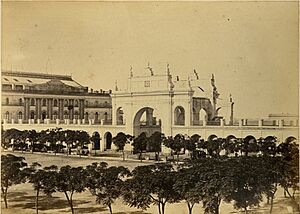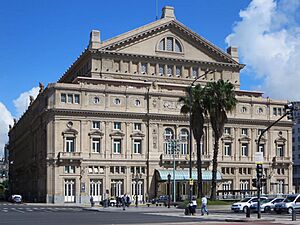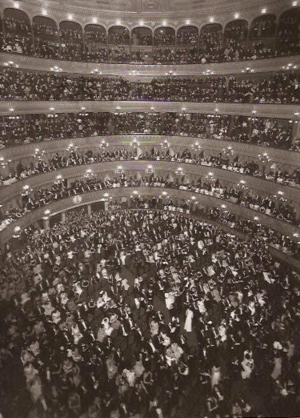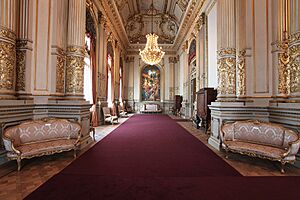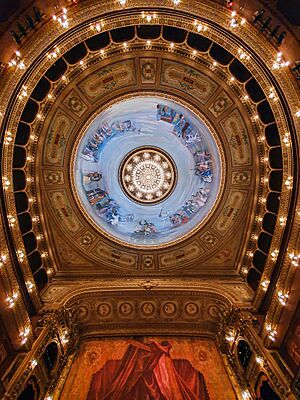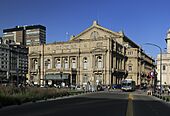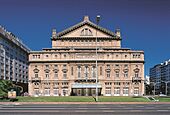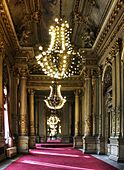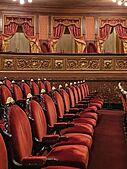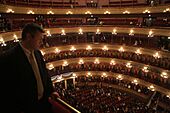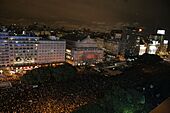Teatro Colón facts for kids
Quick facts for kids Columbus Theatre |
|
|---|---|
|
Teatro Colón
|
|
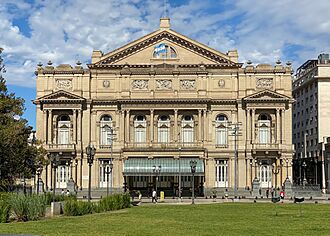
Main façade of Teatro Colón
|
|
| General information | |
| Type | Theatre |
| Architectural style | Eclectic |
| Location | Buenos Aires, Argentina |
| Address | Tucumán 1171 |
| Construction started | 1889 |
| Completed | 1908 |
| Opened | 1908 |
| Renovated | 2001–2010 |
| Owner | City of Buenos Aires |
| Height | 28 metres |
| Dimensions | |
| Diameter | 58 metres |
| Technical details | |
| Structural system | Concrete |
| Design and construction | |
| Architect | Francesco Tamburini Julio Dormal Vittorio Meano |
| Other information | |
| Seating capacity | 2,478 |
The Teatro Colón (which means Columbus Theatre in English) is a famous opera house in Buenos Aires, Argentina. Many people think it's one of the best opera houses in the world. National Geographic even called it one of the top ten!
Experts say the Teatro Colón has amazing sound. One expert, Leo Beranek, asked many opera and orchestra directors. They said it has the best sound for opera and the second best for concerts anywhere.
The theatre you see today replaced an older one that opened in 1857. People realized a new, bigger theatre was needed. After 20 years of work, the current theatre opened on May 25, 1908. The first show was Aïda, a famous opera by Giuseppe Verdi.
Many top singers and opera groups from around the world visited the Teatro Colón. They often traveled to other cities like Montevideo, Rio de Janeiro, and São Paulo afterwards.
Over time, the theatre needed a lot of work. Big plans were made for renovations. The theatre closed for a major update from October 2006 to May 2010. It reopened on May 24, 2010, with a special show for its new season.
In 1991, the Teatro Colón was named a National Historic Monument of Argentina. This means it's a very important building for Argentina's history.
Contents
History of the Teatro Colón
The Teatro Colón has had two main buildings. The first one was in Plaza de Mayo and was used until 1888. The second, and current, building is in front of Plaza Lavalle. It took 20 years to build and opened in 1908. This spot used to be the Park Station, which was Argentina's first train station.
Throughout its history, many famous artists have performed at the Teatro Colón. These include opera singers, classical musicians, and ballet dancers. Some well-known names are Maria Callas, Luciano Pavarotti, Plácido Domingo, and Mikhail Barishnikov. Many talented Argentine artists have also performed there, like Martha Argerich and Astor Piazzolla. In recent years, popular artists like Chris Cornell and Sarah Brightman have also played there.
In the 1920s, the theatre created its own groups of performers. In 1931, the city of Buenos Aires took over its management. Later, in 1946, there were efforts to make the theatre more open to different types of music and more people. These efforts were stopped for a while but started again in 1983.
A big restoration project began in 2006 and finished in 2010. The theatre reopened on May 24, 2010. This was a special event, celebrating Argentina's 200th birthday as a nation.
The First Teatro Colón Building
The first Teatro Colón was designed by Charles Pellegrini. It was a popular place for over 30 years. It had 2,500 seats, including a special area for people who were in mourning. Construction started in 1856 and finished in 1857.
The first theatre opened on April 27, 1857. The first show was Verdi's opera La traviata. This was only four years after the opera first premiered in Italy! The main singers were Sofia Vera Lorini and Enrico Tamberlik.
This first theatre closed on September 13, 1888. It made way for the new, improved building. The new theatre opened 20 years later on Libertad street. The delay was partly because of money problems in 1890.
Before the current Teatro Colón, opera shows happened in other theatres. The first Teatro Colón and the Teatro Opera were the most important. The main opera company from Teatro Opera moved to the new Teatro Colón in 1908. Other theatres like Teatro Politeama and Teatro Coliseo also hosted big shows.
The Current Teatro Colón Building
What Makes It Special
The theatre is located in the heart of Buenos Aires. It's surrounded by 9 de Julio Avenue (Cerrito Street), Libertad Street (where the main entrance is), Arturo Toscanini Street, and Tucumán Street. It sits on land that used to be a train station.
The main hall where shows happen is shaped like a horseshoe. It has 2,487 seats, which is more than the Royal Opera House in London. There's also standing room for 1,000 people. The stage is very large: 20 meters wide, 15 meters high, and 20 meters deep.
The building has six floors above ground and three floors below. It has seven elevators. The outside is made of beautiful stone. Inside, there's a huge chandelier with 700 light bulbs! The first architect was Italian Francesco Tamburini. After he passed away, the Belgian architect Julio Dormal finished the building. The original hall had special boxes with metal screens. This allowed people in mourning to watch shows without being seen.
The sound quality, or acoustics, at the Teatro Colón is amazing. Many people believe it's one of the top five best places in the world for performances. Famous singer Luciano Pavarotti also thought the sound was incredible.
Opening and Later Years
The current theatre, the second one with this name, opened on May 25, 1908. It took 20 years to build. The opening show was Aida, performed by an Italian company. The conductor was Luigi Mancinelli, and the main singers were Amedeo Bassi and Lucia Crestani. The next show was Hamlet with the famous singer Titta Ruffo. During that first season, 17 different operas were performed with many famous stars.
The first stone for the current Teatro Colón was laid in 1889. Architect Francesco Tamburini and his student, Vittorio Meano, started the design. They wanted a grand theatre like those in Europe. But there were many delays. Money problems, arguments about where to build it, and the deaths of Tamburini in 1891 and Meano in 1904 caused problems. An Italian businessman, Angelo Ferrari, who was paying for the theatre, also passed away. Finally, the building was finished in 1908 by the Belgian architect Julio Dormal. He made some changes to the design and added French-style decorations. The sculptures on the outside were made by Luigi Trinchero.
The theatre opened on May 25, which is Argentina's Día de la Patria (Homeland Day). It quickly became a world-famous opera spot. It was as important as La Scala in Italy and the Metropolitan Opera in New York. The best opera singers and conductors wanted to perform there.
In 1910, a bomb was thrown into the theatre by anarchists. Georges Clemenceau, a French leader, was in Argentina at the time. He described the event as terrible, with blood everywhere. But the theatre was quickly repaired. The next day, society women still came to the show, showing great strength.
Ballet stars also performed at the Colón, along with Argentine dancers and musicians. One famous ballerina was Lida Martinoli. After she stopped dancing, she became a choreographer. A sad event happened in 1971. Two very famous Argentine dancers, Norma Fontenla and José Neglia, died in a plane crash. A monument in Lavalle Square remembers them.
The theatre's inside is decorated in rich red and gold. The cupola (the dome-shaped ceiling) has paintings from 1966. These were done by the artist Raúl Soldi during a renovation.
Big Renovation (2005–2010)
In recent years, the Teatro Colón faced some challenges. But it slowly started to get better. The theatre went through a huge renovation inside and out. At first, shows continued while work was done. But in December 2006, all performances stopped for a full refurbishment.
The renovation was much bigger than planned. It was supposed to take 18 months and cost $25 million. Instead, it took three years and cost $100 million! About 1,500 workers, including 130 architects and engineers, worked on it. In total, 60,000 square meters of the building were updated.
Some of the last shows before the theatre closed were Swan Lake on September 30. The last opera was Boris Godunov on October 28. The very last performance before the big closure was a concert on November 1. It featured the folk singer Mercedes Sosa with the Argentine National Symphony Orchestra.
The theatre was supposed to reopen for its 100th birthday in May 2008. But there were delays. It finally reopened with a special gala concert on May 24, 2010. This was just before its 102nd birthday and Argentina's 200th anniversary. They performed Swan Lake and a part of Puccini's La bohème. A private concert was held on May 6, 2010, to test the sound. On September 6, 2013, the Teatro Colón hosted the opening ceremony for the 125th Session of the International Olympic Committee.
Image gallery
See also
 In Spanish: Teatro Colón para niños
In Spanish: Teatro Colón para niños
- List of buildings
- List of concert halls
- Libertad Palace


